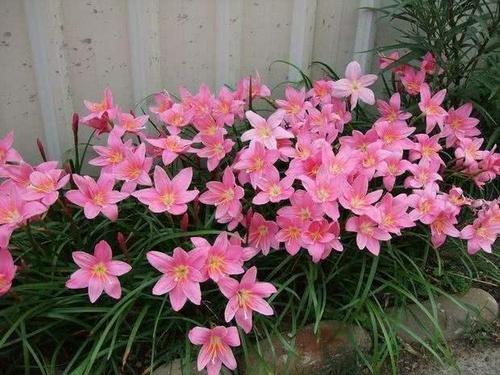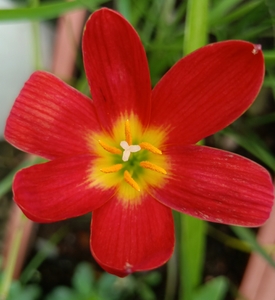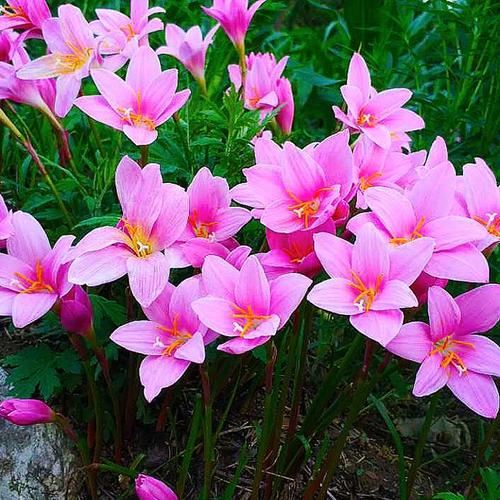Pink rain lily profile
Written by Maggie
Sep 11 2021

Pink rain lily is a shade-loving plant native to tropical America. Its plant is about 15-30 cm high and clumped. Leaves are linear, very similar to leek. The flower stem is extracted from the leaf cluster, and the petals are 6. The flowers of the Pink Rain Lily are large and Pink with slightly drooping petals. Pink Rain Lily is a thick peach color, and every bulb of the adult plant can blossom. The clusters of flowers shine brilliantly in the bright sun, charming and charming, and are loved by everyone. Leek stage is from April to September; Pink rain lily is suitable for garden flower bed edge or potted.
Pink rain lily picture
Morphological characteristics of Pink rain lily
Pink rain lily is a perennial herb. Bulb is ovoid, 2-3 cm in diam.Basal leaves are constantly fascicled, linear, flat, 15 -- 30 cm long, 6 -- 8 mm wide. Flowers of pink rain lily are solitary at the apex of the flower stem, the involucre of a flactyl-like flower under, involucre often purplish red, 4 -- 5 cm long, the lower part connate into a tube; Pedicels are 2-3 cm long;Flowers rose red or pink; Perianth tubes are 1-2.5 cm long, perianth lobes 6, lobes obovate, apically slightly pointed, 3-6 cm long; pink rain lily has 6 stamens, ca. 2/3-4/5 of perianth, anthers T-shaped; Ovary is inferior, 3 locules, ovule many, style long and slender, stigma deep 3 lobed. Capsule is subglobose; Seeds of Pink rain lily are black. Flowering period is in summer and autumn.
The plant of Pink Rain Lily is about 15-30 cm high and clumps. Leaves are linear, very similar to leek. The flower stem is drawn from the leaf cluster, and the petals are mostly 6, sometimes 8. Pink Rain Lily has large, Pink flowers with slightly curved petals and thick peach. Every bulb of the plant can blossom. The clusters of flowers shine brilliantly in the bright sun, charming and charming, and are loved by everyone.Pink rain lily flowering from April to September; Pink rain lily is suitable for garden flower bed edge or potted. Different from the common Pink Rain Lily: the flowers are smaller, the color is darker and more brilliant, the petals are stiff and not easy to sag, and the flower shape can be kept well. Due to soil changes, varieties of Pink Rain Lily will also change. For example, greenhouses in northern China have broad and thick leaves, while greenhouses in California have narrow leaves and strong fragrance.
Pink rain lily growing environment
Pink Rain Lily has a strong nature, drought resistance and high temperature resistance, and it is easy to grow. The suitable temperature for growth is 22-30 degrees, and the fertile sandy loam is the best soil for cultivation.
Pink Rain Lily likes light, but can also tolerate half shade. They like warm environments, but are hardy to cold. Deep, flat, well drained loam or sandy loam. Pink rain lily likes wet, afraid of water. Pink rain lily has strong adaptability, resistance to diseases and insects, strong bulb germination, easy reproduction.
Pink rain lily growing methods
Pink rain lily likes full sunshine, warm environment, clay, loam, culture, soil and other media can be grown. Long - term compound fertilizer is applied once a season. Growth robust, open cultivation does not need to deliberately water, potted observation medium dry before watering.

Pink rain lily application
In summer Pink rain lily is often in full bloom after rain, flowers such as blanket effect is no worse than the general grass flowers, in the road safety island, tree holes, slope, park, campus and other environments as ground cover plants have a good ornamental effect, and extensive management is simple. Pink rain lily growth rate is slow, to achieve the effect of ground cover plants, plant density must be high.
Pink rain lily propagation methods
For the propagation of Pink Rain Lily, it can be planted by dividing plants or bulbs, which can be carried out throughout the year, but spring is the best. As long as the bulb root of Pink rain lily dug up, each plant 3-5 balls, watering to maintain appropriate humidity, was easy to survive. When digging the bulb, take care not to hurt the bulb. If there are too many Pink rain lily leaves and stems, cut off the upper part, leaving the bulbs intact and the leaves 6-8 cm long. If the bulb buds have germinated, the branches after watering, still can bloom.
Disease of Pink rain lily
Pink rain lily main diseases are leaf rust, speckled disease, grubs.

Latest Updated
- Benefits of Bugleweed - 7 Science-backed Health Benefits
- Bugleweed Dangers & Side Effects - Is It Poisonous?
- How to Plant Evergreen Trees - What You Should Know
- When to Plant Evergreens - Grow Guide for Evergreen Trees
- 12 Wonderful Evergreen Shrubs for Your Garden
- 12 Popular Evergreen Plants with Pictures for Beginners
- When And How To Prune A Lilac Bush Like a Pro
- How to Grow & Care for Lilac Vine (Hardenbergia Violacea)
- Japanese Lilac Tree (Syringa Reticulata) Care & Propagation Guide
- Shumard Oak Pros and Cons - What to Know
Popular Articles
- Winter maintenance of Antirrhinum Majus
- How to Grow Terminalia Mantaly Tree
- How to Grow and Care for Crossostephium Chinense
- How to grow Antirrhinum Majus in spring
- Peristeria Elata (Dove Orchid) Profile: Info & Care Guide
- Underwatered Snake Plant (Sansevieria Trifasciata) - Signs And How To Fix
- How to Care for Brazilian Jasmine Plant (Mandevilla Sanderi)
- How to Grow & Care for Graptopetalum Purple Delight in Summer
- Rosa Chinensis (China Rose): Plant Growing & Care Tips
- How to Care for Baby Sun Rose (Aptenia Cordifolia)